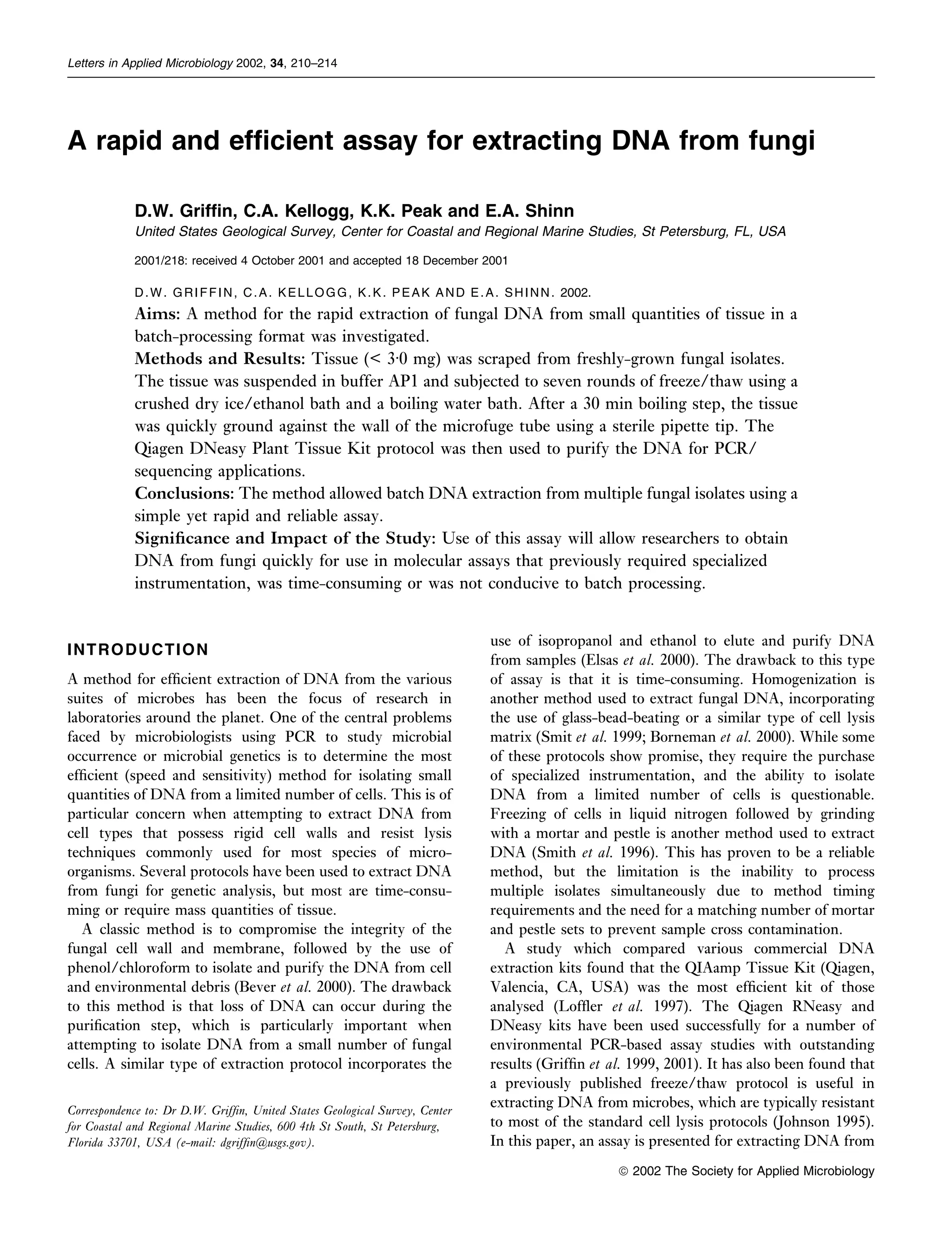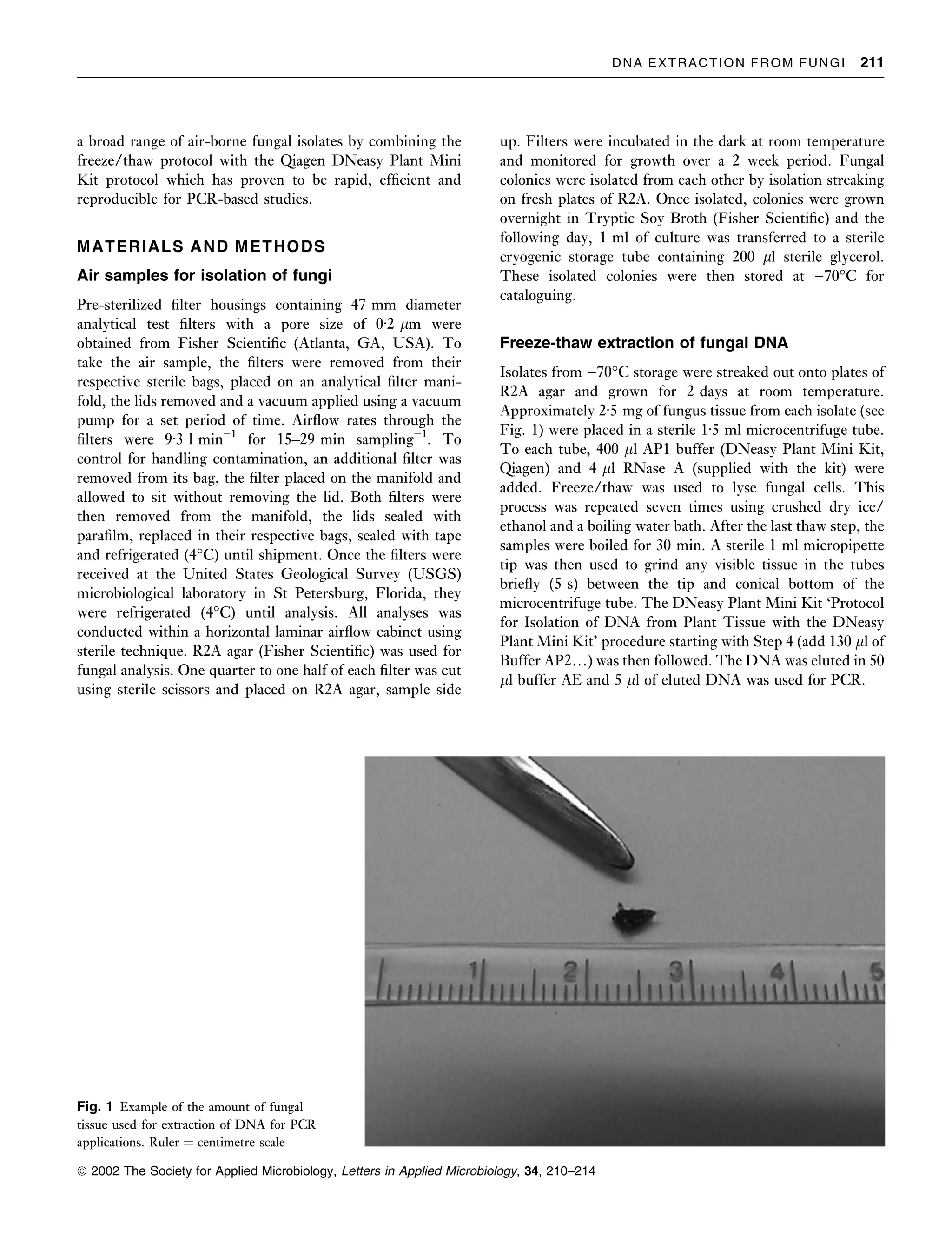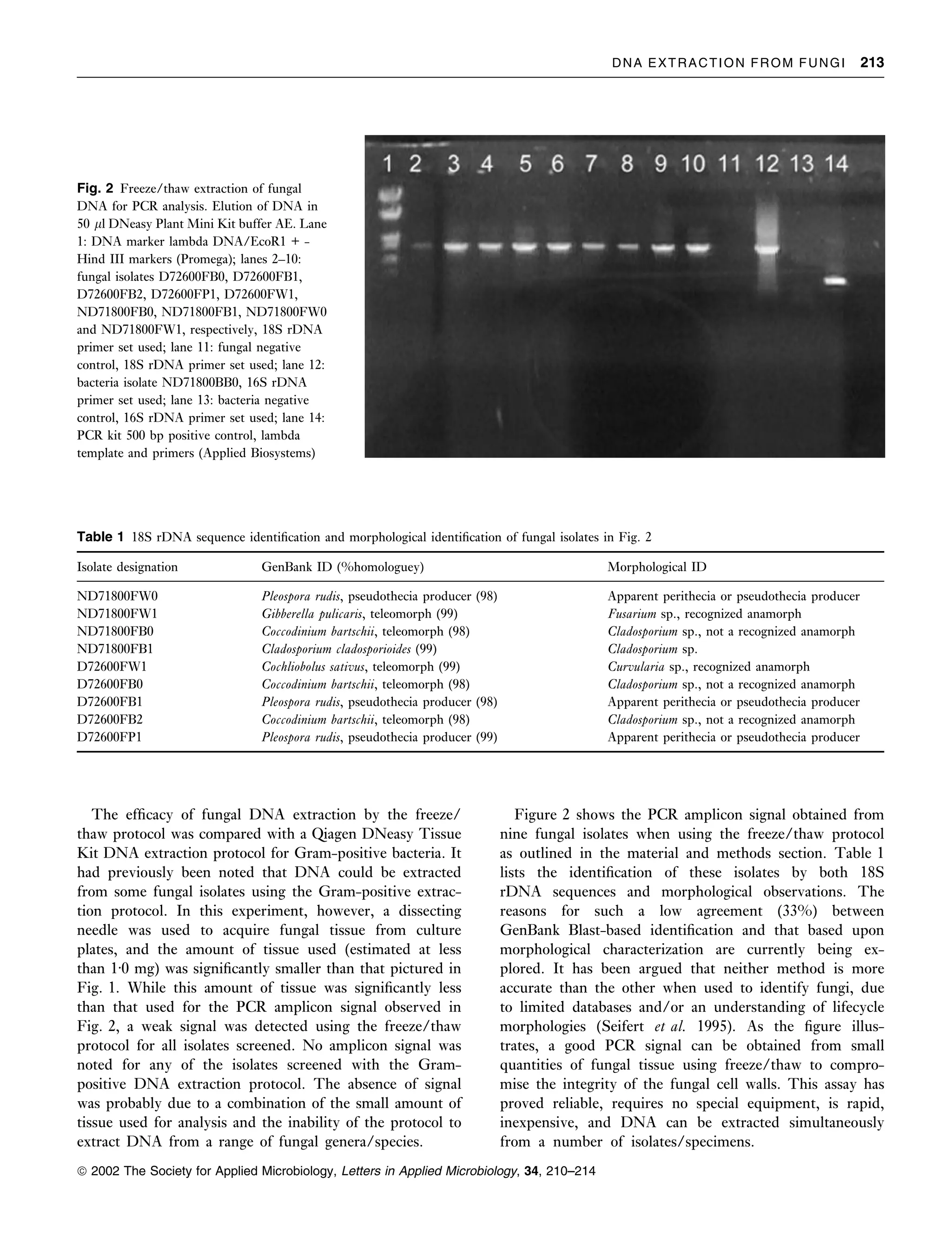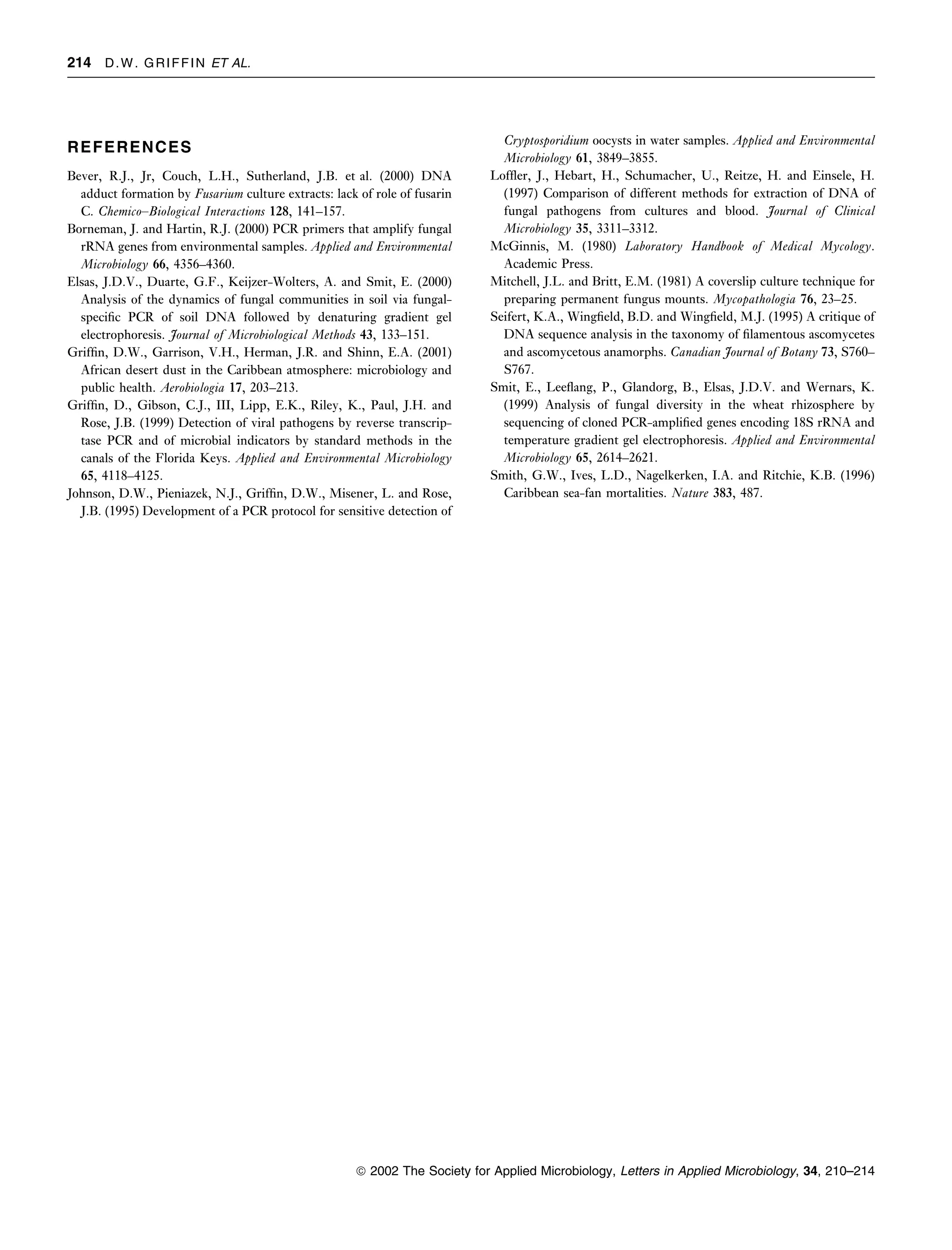The document describes a new rapid method for extracting DNA from fungi in a batch format. The method involves scraping fungal tissue, subjecting it to seven rounds of freeze/thaw lysis using dry ice and boiling water, followed by boiling for 30 minutes and grinding. The Qiagen DNeasy Plant Tissue Kit is then used to purify the extracted DNA. Testing showed this new method allowed effective DNA extraction from multiple fungal isolates simultaneously in a simple and reliable way. It provides researchers an improved technique for obtaining DNA from fungi for molecular assays compared to more specialized or time-consuming existing methods.


![212 D . W . G R I F F I N ET AL.
Bead-beating extraction of fungal DNA Preparation of isolates for morphological
characterization
Isolates from )70°C storage were streaked onto plates of
R2A agar and grown for 2 days at room temperature. Isolates were grown for whole thallus and microscopic
Approximately 2Æ5 mg of fungus tissue from each isolate characterization on R2A agar at room temperature. Isolate
were then transferred to sterile 2Æ0 ml cryogenic/microcen- purity was achieved by streak-plating fruiting bodies on
trifuge tubes equipped with an O-ring. To each fungus R2A. After 1–3 days of development at room temperature,
tissue sample, 400 ll AP1 buffer (DNeasy Plant Mini Kit) single, well-isolated microthalli were visualized with a hand
and 4 ll RNase A (supplied with the kit) were added. To lens or dissecting microscope and re-plated on R2A to assure
each tube, a volume of sterile glass beads (0Æ1 mm diameter, isolate purity. Thalli were screened with a dissecting
BioSpec Products, Inc., Bartlesville, OK, USA) approxi- microscope or hand lens at 2–3 day intervals; once evident,
mately equal to 100 ll was also added. Tubes were loaded in fruiting bodies were examined microscopically using tape
a Mini-BeadBeater-8 (BioSpec Products). Samples were mounts, tease mounts (McGinnis 1980) or coverslip pre-
bead-beaten for 2 min at maximum speed. They were then parations in Lactophenol Cotton Blue mounting fluid. In a
chilled on ice for 5 min. The bead-beating/cooling steps variation on the technique of Mitchell and Britt (1981),
were repeated twice. The samples were then centrifuged for coverslip preparations were made by streak-plating a
10 min at 14 000 rev min)1 in a microcentrifuge. The microthallus to an R2A plate and then embedding three
supernatant fluid from each tube was transferred to a sterile sterile coverslips (at a 45° angle) into the agar, at the point of
1Æ5 ml microcentrifuge tube. The DNeasy Plant Mini Kit heaviest inoculum. Developing aerial mycelia and fruiting
‘Protocol for Isolation of DNA from Plant Tissue with the bodies adhered to the embedded coverslips. The coverslips
DNeasy Plant Mini Kit’ procedure starting with Step 4 (add were mounted successively, at two to several day intervals,
130 ll of Buffer AP2…) was then followed. The DNA was allowing for a ‘time-lapsed’ study of progressive fruiting
eluted in 50 ll buffer AE and 5 ll of eluted DNA was used body development.
for PCR.
RESULTS AND DISCUSSION
Genetic identification of microbial isolates
Early laboratory experiments, which investigated a number
PCR was used for 18S rDNA amplification using a of methods for efficient extraction of fungal DNA in a
universal fungal primer set [EF3 and EF4]. The PCR batch-processing format, indicated the need for an alternat-
master mix recipe per reaction was: 10 ll GeneAmp 10· ive protocol. To address the applicability of freeze/thaw in
PCR buffer (Applied Biosystems), 12 ll 25 mmol l)1 extracting fungal DNA, several experiments were conduc-
MgCl2 (Applied Biosystems), 2 ll 10 mmol l)1 dNTP ted, with stepwise modifications to each, in an effort to
mix (Promega), 0Æ5 ll 5 U ll)1 Taq polymerase determine the most reliable assay. Once an assay demon-
(Promega), 1 ll each of 10 nmol l)1 upstream and down- strated potential, it was compared with a bead-beating
stream primer (synthesized by Operon Technologies, Inc.) extraction assay. In this experiment, no PCR amplicon was
and 69 ll 0Æ02 lm filter-sterilized autoclaved H2O. The detected using bead beating, and a light to heavy PCR
PCR amplification profile used was: one cycle for 2 min at amplicon signal was detected using freeze/thaw (three
94°C, 40 cycles of [30 s at 94°C, 30 s at 45°C, 2 min at specimens ¼ Sclerotium sp., Aspergillus versicolor and
72°C], one cycle of 10 min at 72°C, and hold at 4°C. After Coccodinium bartschii). In this experiment, the DNA
PCR, amplicon was cleaned and eluted using a QIAquick captured in the Qiagen Plant Tissue Kit spin column was
PCR Purification Kit (Qiagen). Amplicon was cloned into eluted in 50 ll of water for PCR analysis. In later
a plasmid vector using a TOPO TA Cloning Kit experiments it was found that elution into the Qiagen Plant
(Invitrogen Corp., Carlsabad, CA, USA). Plasmid was Tissue Kit buffer AE (as recommended) resulted in an
isolated from the TOPO TA cloning Kit host using a enhanced PCR signal. One of the more widely used
WizardÒ Plus SV Miniprep Kit (Promega). Clones were protocols for extracting fungal DNA is the use of liquid
verified using EcoR I digestion (Promega), following the nitrogen and a mortar and pestle, as stated in the introduc-
manufacturers directions, and electrophoresis. Plasmid tion. The Qiagen DNeasy Plant Tissue Kit recommends the
insert (PCR amplicon) was sequenced (single strand, one use of this approach prior to using the kit to purify and elute
reaction, approximately 750 bases) by the University of the DNA. The drawbacks of this protocol, as stated, are the
Florida DNA Sequencing Core Laboratory (Gainesville, limitation on batch processing and precautions needed for
FL, USA). GenBank Blast search (http://www.ncbi. use of liquid nitrogen. It should be stated that liquid
nlm.nih.gov/BLAST/) was used for amplicon/isolate nitrogen could be used in place of a crushed dry ice/ethanol
identification. bath for freezing samples in the freeze/thaw protocol.
ª 2002 The Society for Applied Microbiology, Letters in Applied Microbiology, 34, 210–214](https://image.slidesharecdn.com/arapidandefficientassayforextractingdnafromfungi-130110233136-phpapp02/75/A-rapid-and-efficient-assay-for-extracting-dna-from-fungi-3-2048.jpg)

